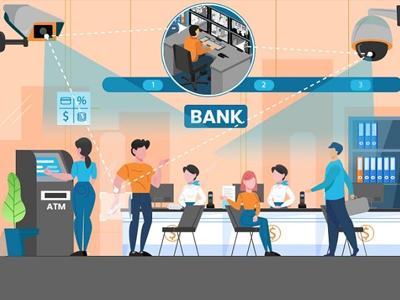Enhancing Bank Security: Leveraging E-Surveillance to Combat Crime and Minimize Financial Losses

Thefts and robberies can significantly impact a bank's customers, business, and employees. Banks have deployed multiple safety barriers to curtail such crimes. However, the increase in ATMs and digital transactions introduces new vulnerabilities. E-surveillance can play a crucial role in addressing these challenges and enhancing overall security.
Challenges Faced by Banks
1. Cybersecurity: With the rise of online banking, banks face heightened risks as criminals develop sophisticated methods to access customer data.
2. Physical Theft: Despite digital advancements, theft and burglaries still pose significant risks, necessitating robust security measures.
3. Money Laundering: Banks must remain vigilant to prevent criminals from laundering money through their systems, adhering to strict regulatory guidelines.
4. Fraud: Potential fraud, such as identity theft, requires banks to implement measures to protect their customers.
5. Counterfeit Money: Ensuring counterfeit money does not enter cash reserves is critical to maintaining system integrity.
Leveraging AI, ML, and Digitalization
The growing threats compel banks to harness advanced digital technologies to safeguard human lives, assets, and information.
AI-Based Video Surveillance Systems
AI-based video surveillance systems are essential in banking. They help predict and deter criminal activities before they occur. These systems can analyze video data to generate actionable insights, enabling bank staff to make informed decisions quickly.
IoT-Enabled Security Systems
IoT-enabled security systems provide an extra layer of safety. They enable banks to monitor premises and customers closely, responding swiftly to suspicious activity. These systems can also monitor customer behavior, offering valuable insights for improving customer experience and developing security strategies.
Steps Banks Can Take to Secure Assets, Employees, and Data
1. Implement Video Surveillance Systems: Central monitoring executives can ensure round-the-clock security using software to detect and deter suspicious incidents and transactions.
2. Establish Benchmarking and Peer Comparison: Comparing financial activity against industry benchmarks helps identify areas needing increased security and potential risks.
3. Implement Financial Transaction Controls: Use authentication and encryption measures, global sanctions screening, and suspicious activity monitoring to ensure proper authorization and monitoring of transactions.
4. Integrate Risk Management into Business Operations: Embedding risk management and e-surveillance strategies in all operations helps identify and mitigate security threats timely.
5. Perform Regular Risk Assessments: Regular assessments ensure systems and processes are up-to-date and compliant with regulations and best practices.
Benefits of Video Surveillance and Analytics for Banks
1. Increased Security: Video surveillance deters malicious activity and protects customers, employees, and the bank's reputation. Video analytics can detect unusual behavior indicating potential robberies or illicit activities.
2. Improved Customer Service: Monitoring customer activity can help staff quickly identify needs and address suspicious behavior, enhancing customer service.
3. Fraud Detection: Video surveillance detects fraud among employees and customers by identifying unusual transactions and suspicious behavior.
4. Enhanced Compliance Monitoring: Surveillance ensures compliance with regulations and internal policies, reducing risks and ensuring a secure environment.
5. Improved Efficiency: Surveillance and analytics monitor staff performance and eliminate operational bottlenecks, enhancing efficiency.
6. Cost Savings: Implementing surveillance and analytics reduces the need for manual monitoring, lowering labor costs.
By leveraging e-surveillance technologies, banks can enhance security, improve customer service, detect fraud, ensure compliance, increase efficiency, and save costs, thereby curtailing financial losses and mitigating risks.
(This "Security Blogs" Published in August 2024 Edition)




.png)







